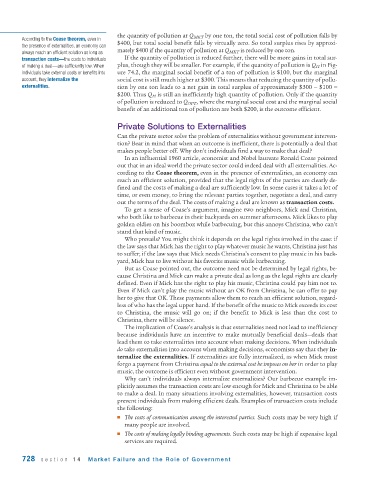Page 770 - Krugmans Economics for AP Text Book_Neat
P. 770
the quantity of pollution at Q MKT by one ton, the total social cost of pollution falls by
According to the Coase theorem, even in
$400, but total social benefit falls by virtually zero. So total surplus rises by approxi-
the presence of externalities, an economy can
mately $400 if the quantity of pollution at Q MKT is reduced by one ton.
always reach an efficient solution as long as
transaction costs—the costs to individuals If the quantity of pollution is reduced further, there will be more gains in total sur-
of making a deal—are sufficiently low. When plus, though they will be smaller. For example, if the quantity of pollution is Q H in Fig-
individuals take external costs or benefits into ure 74.2, the marginal social benefit of a ton of pollution is $100, but the marginal
account, they internalize the social cost is still much higher at $300. This means that reducing the quantity of pollu-
externalities. tion by one ton leads to a net gain in total surplus of approximately $300 − $100 =
$200. Thus Q H is still an inefficiently high quantity of pollution. Only if the quantity
of pollution is reduced to Q OPT , where the marginal social cost and the marginal social
benefit of an additional ton of pollution are both $200, is the outcome efficient.
Private Solutions to Externalities
Can the private sector solve the problem of externalities without government interven-
tion? Bear in mind that when an outcome is inefficient, there is potentially a deal that
makes people better off. Why don’t individuals find a way to make that deal?
In an influential 1960 article, economist and Nobel laureate Ronald Coase pointed
out that in an ideal world the private sector could indeed deal with all externalities. Ac-
cording to the Coase theorem, even in the presence of externalities, an economy can
reach an efficient solution, provided that the legal rights of the parties are clearly de-
fined and the costs of making a deal are sufficiently low. In some cases it takes a lot of
time, or even money, to bring the relevant parties together, negotiate a deal, and carry
out the terms of the deal. The costs of making a deal are known as transaction costs.
To get a sense of Coase’s argument, imagine two neighbors, Mick and Christina,
who both like to barbecue in their backyards on summer afternoons. Mick likes to play
golden oldies on his boombox while barbecuing, but this annoys Christina, who can’t
stand that kind of music.
Who prevails? You might think it depends on the legal rights involved in the case: if
the law says that Mick has the right to play whatever music he wants, Christina just has
to suffer; if the law says that Mick needs Christina’s consent to play music in his back-
yard, Mick has to live without his favorite music while barbecuing.
But as Coase pointed out, the outcome need not be determined by legal rights, be-
cause Christina and Mick can make a private deal as long as the legal rights are clearly
defined. Even if Mick has the right to play his music, Christina could pay him not to.
Even if Mick can’t play the music without an OK from Christina, he can offer to pay
her to give that OK. These payments allow them to reach an efficient solution, regard-
less of who has the legal upper hand. If the benefit of the music to Mick exceeds its cost
to Christina, the music will go on; if the benefit to Mick is less than the cost to
Christina, there will be silence.
The implication of Coase’s analysis is that externalities need not lead to inefficiency
because individuals have an incentive to make mutually beneficial deals—deals that
lead them to take externalities into account when making decisions. When individuals
do take externalities into account when making decisions, economists say that they in-
ternalize the externalities. If externalities are fully internalized, as when Mick must
forgo a payment from Christina equal to the external cost he imposes on her in order to play
music, the outcome is efficient even without government intervention.
Why can’t individuals always internalize externalities? Our barbecue example im-
plicitly assumes the transaction costs are low enough for Mick and Christina to be able
to make a deal. In many situations involving externalities, however, transaction costs
prevent individuals from making efficient deals. Examples of transaction costs include
the following:
■ The costs of communication among the interested parties. Such costs may be very high if
many people are involved.
■ The costs of making legally binding agreements. Such costs may be high if expensive legal
services are required.
728 section 14 Market Failure and the Role of Gover nment

